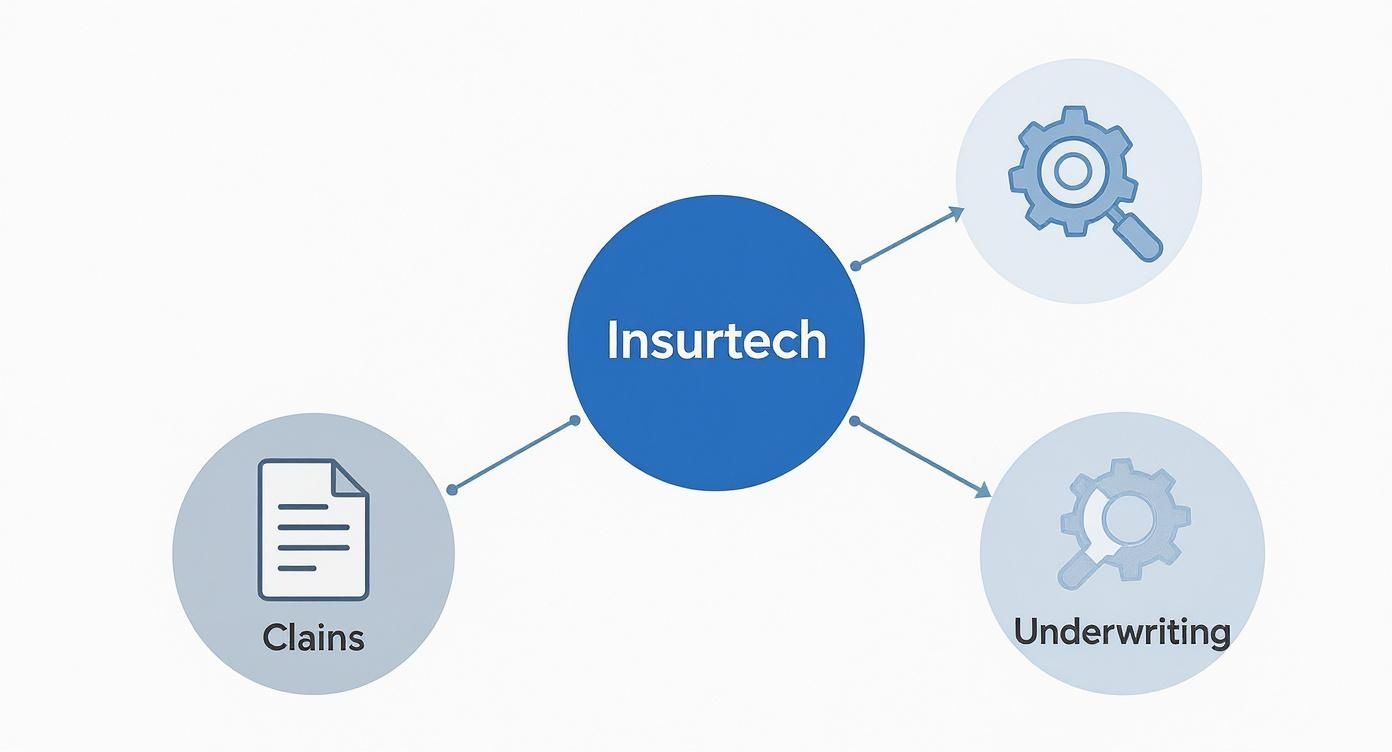Think of the last time you had to deal with an insurance company. Was it a smooth, digital experience, or did it involve endless paperwork, long phone calls, and frustrating delays? For decades, the industry has been bogged down by manual processes. Insurtech solutions are changing all that, bringing the speed and simplicity we expect from modern technology to the world of insurance.
What Are Insurtech Solutions and Why Do They Matter?

At its heart, “insurtech” is just a shorthand for “insurance” and “technology.” It represents a massive shift away from the old-school, legacy systems that have been the industry’s backbone for years. Instead of relying on physical files and manual data entry, insurtech platforms use digital tools to manage everything, from selling a new policy to settling a claim.
The difference is like depositing a physical cheque at a bank versus sending an e-transfer from your phone. Insurtech delivers that same level of instant, on-demand service to insurance. It’s not about reinventing the fundamental concept of insurance; it’s about rebuilding its operational engine with smarter, faster technology to meet today’s customer expectations.
The Key Drivers Behind the Insurtech Movement
This isn’t just technology for technology’s sake. A few powerful forces are compelling the insurance industry to adapt, making insurtech a necessary evolution, not just a passing trend.
- Evolving Customer Expectations: We’ve all been conditioned by companies like Amazon and Netflix to expect seamless digital service. We want instant quotes, simple policy management on an app, and quick, painless claim settlements.
- Operational Inefficiency: Let’s face it, traditional insurance processes are often slow, expensive, and filled with opportunities for human error. Insurtech automates the repetitive, mundane tasks, which lets your team focus on higher-value work that actually requires a human touch.
- Data-Driven Decision Making: The industry is sitting on a mountain of data. Insurtech provides the tools to actually make sense of it all, leading to more accurate risk assessments, personalized products, and fairer pricing for customers.
- Competitive Pressure: New, tech-first startups are entering the market and shaking things up. They are nimble and built for the digital age, forcing established carriers to either modernize or risk being left behind.
To really get why this matters so much, you have to look at the bigger picture of digital transformation in customer experience, which is changing how businesses in every sector connect with their clients.
California as a Hub for Insurtech Growth
You can see the momentum building in major tech hubs, and California, specifically Silicon Valley, is a clear epicentre of this growth. In the first quarter of 2025 alone, the region’s share of global insurtech deals shot up from 10.9% to 21.9% year-over-year.
That surge was fuelled by $0.3 billion in funding for local startups in that quarter. This isn’t just a blip; it highlights how critical the region has become in creating the next generation of insurance technology. You can read the full report on insurtech trends to learn more.
A Look at the Core Insurtech Solutions
To really get a handle on insurtech’s impact, it helps to see it not as one big thing, but as a collection of specialized tools. Each one is designed to tackle a specific, long-standing headache in the insurance world. When they work together, they create a much more efficient, accurate, and customer-friendly industry.
From the first quote to the final claim payout, technology is changing how every part of the business operates. Let’s break down the main categories and see what problems they’re actually solving.
To give you a clearer picture, here’s a quick breakdown of the primary types of insurtech solutions and the real-world problems they solve for businesses and insurance carriers.
Key Insurtech Categories and Their Business Impact
| Insurtech Category | Core Function | Primary Business Benefit |
|---|---|---|
| Claims Automation | Uses AI to process and pay claims digitally. | Drastically cuts settlement times, reduces fraud, and frees up human adjusters for complex cases. |
| Dynamic Underwriting | Leverages real-time data to assess risk more accurately. | Enables fairer, more personalized pricing and reduces the insurer’s exposure to unforeseen risks. |
| Policy Administration | Modernizes the core systems for managing policies. | Speeds up product launches, lowers administrative costs, and provides a single source of truth for all data. |
| Digital Distribution | Creates new, online channels for selling insurance. | Increases market reach, makes buying insurance more convenient, and opens up new revenue streams. |
| Telematics & IoT | Gathers data from physical devices to monitor risk. | Shifts risk management from reactive to proactive, preventing losses before they happen. |
These categories represent the building blocks of the modern insurance landscape, each addressing a critical piece of the puzzle. Now, let’s dive a little deeper into how they function in the real world.
AI-Powered Claims Automation
Historically, processing a claim has been a slow, paper-heavy slog involving adjusters, forms, and endless back-and-forth. AI-powered claims automation completely changes the game by using smart algorithms to manage the process digitally, often in real-time.
Picture this: a policyholder has a minor fender-bender. Instead of calling an agent and waiting days for an adjuster, they just snap a few photos of the damage with their phone. An AI system instantly analyzes the images, cross-references repair costs from a huge database, confirms the policy coverage, and approves the claim. The whole thing can be over in minutes.
This isn’t some far-off concept; it’s happening right now. Insurers using this tech are seeing claim settlement times drop from weeks to just a few minutes. This is a massive win for customer satisfaction and lets human adjusters focus their expertise on the really complex cases.
Dynamic Underwriting and Risk Assessment
Underwriting has always been a mix of art and science, the science of evaluating risk. For decades, this relied on broad statistical tables and demographic data. Today’s insurtech makes this process incredibly precise by pulling in massive amounts of real-time data.
So, instead of just using age and postal code to set a car insurance premium, an underwriter can now look at telematics data showing how a person actually drives. This has opened the door to usage-based insurance (UBI), where safer drivers are rewarded with lower premiums. It’s a much fairer system, pricing risk based on individual behaviour instead of generalized statistics. To dig deeper into how these data models are evolving, you can learn more about predictive analytics in Canadian insurance operations.
Modern Policy Administration Systems
Many insurers are still running on legacy policy administration systems that are clunky, inflexible, and a nightmare to update. They’re like a giant, rusty old filing cabinet; they get the job done, but just barely. The modern answer is a cloud-native core platform.
These new systems act as the digital brain of an insurance company, handling all the essentials:
- Policy Issuance: Creating new policies quickly and without errors.
- Billing and Collections: Automating invoicing and making it easy for customers to pay.
- Endorsements and Renewals: Managing policy changes and renewals without needing someone to push paper.
Moving these functions to a flexible, cloud-based system allows insurers to get new products to market faster, slash administrative costs, and give both their agents and customers a single, clear view of everything.
New Distribution and Sales Channels
Insurtech is also transforming how insurance is sold. The traditional agent-driven model isn’t going away, but it’s now being complemented by digital-first approaches that meet customers right where they are.
One of the biggest shifts here is embedded insurance. This is when insurance is offered as a simple add-on during another purchase. Think about buying a plane ticket online and being offered travel insurance with a single click. Or when you’re buying a new laptop and an e-commerce site offers a protection plan right at checkout.
This approach makes buying insurance incredibly simple and opens up brand new revenue opportunities for insurers and their partners. It seamlessly weaves protection into the customer’s natural buying journey.
Telematics and The Internet of Things (IoT)
Finally, telematics and IoT devices are giving insurers a direct line of sight into real-world risk like never before. This technology involves placing sensors in cars, homes, or even on people (with wearables) to collect data on behaviour and environmental factors.
It works like this:
- Auto Insurance: A small telematics device in a vehicle tracks speed, braking habits, and mileage to build a highly accurate driver risk profile.
- Home Insurance: Smart smoke detectors or water leak sensors can alert both the homeowner and the insurer to a potential disaster before it gets out of hand, preventing massive losses.
- Health Insurance: Fitness trackers can provide data that encourages healthier lifestyles, allowing insurers to offer wellness programs and more personalized health plans.
By connecting the physical world to a digital network, these insurtech tools are turning risk management from a reactive, after-the-fact process into a truly proactive one.
What Are the Real-World Benefits of Insurtech?
Bringing in new technology isn’t just about keeping up with the times. It’s about getting real, measurable results that show up on your balance sheet, strengthen customer loyalty, and give you a genuine advantage in a tough market.
Let’s move past the buzzwords and look at the actual value these platforms deliver. The benefits aren’t just abstract ideas; they’re practical solutions to the industry’s oldest problems, from painfully slow manual work to guesswork in risk assessment.
Turbocharge Your Operations
One of the first things you’ll notice with insurtech is a massive boost in how efficiently your business runs. So many traditional insurance workflows are bogged down by repetitive, manual tasks, such as data entry, checking documents, and double-checking policy details.
These tasks aren’t just slow; they’re a breeding ground for human error, which leads to expensive fixes and compliance headaches. Insurtech automates this grind, freeing up your talented people to focus on what they do best: handling complex claims, nurturing client relationships, and making strategic decisions.
By automating routine admin work, some P&C carriers have slashed their underwriting timelines by more than 50%. That’s not a small tweak. It’s a complete overhaul that lets them write more business, faster, and with fewer mistakes.
This automation has a direct impact on your operational costs. When you cut down the hours spent on manual labour and reduce errors, your overhead drops and your combined ratio, a vital measure of profitability, improves.
The infographic below shows how different pieces of the insurtech puzzle, like claims, underwriting, and policy admin, all work together to make this happen.

Think of each part of this wheel as a critical function. When you upgrade it with technology, you contribute to a leaner, more responsive business.
Create a Customer Experience People Actually Like
Modern customers expect smooth, fast, and transparent digital service everywhere they go. Insurtech gives you the tools to not only meet but beat those expectations, turning what used to be a frustrating process into a positive experience.
Just look at the claims process. With a digital-first setup, a policyholder can file a claim on their phone in minutes, get real-time updates, and receive a payout in a fraction of the traditional time. That kind of service builds incredible trust and keeps customers coming back.
But the improvements go well beyond claims. Digital platforms give customers:
- Self-Service Portals: They get 24/7 access to view policies, make payments, and update their info without ever needing to call an agent.
- Faster Quotes: You can provide instant, accurate quotes online, capturing new business before a prospect shops around.
- Personalized Communication: You can use data to send relevant information and offers, making customers feel like you actually know them.
A great customer journey is a massive competitive advantage. It’s so important, in fact, that many are now exploring how to build an AI-driven customer experience in insurance to make every interaction even more personal and meaningful.
Make Smarter Decisions on Risk and Profit
Finally, insurtech platforms give you the data-driven insights you need to make smarter, more profitable decisions. Old-school underwriting often relied on broad, static data, which could easily lead to mispriced risk. You either charged too much and lost the business, or you charged too little and ended up with an unprofitable policy.
Insurtech flips the script. It pulls in massive amounts of specific, real-time data from telematics, IoT sensors, and other third-party sources. This allows for a much more detailed and accurate picture of risk.
For example, satellite imagery can give you an immediate, on-the-ground view of property damage after a storm. This lets you assess your exposure and process claims with incredible speed and precision. This proactive approach doesn’t just improve claims; it helps you manage the risk across your entire portfolio. Better data leads to better pricing, fewer losses, and, ultimately, a much healthier bottom line.
Your Roadmap for Implementing Insurtech Solutions

Diving into the world of insurtech can feel like a massive project, but it doesn’t have to be chaos. A well-thought-out plan breaks the process down into manageable steps, making sure you pick the right tools for the right reasons and actually see a return on your investment.
Think of it as your blueprint for a successful digital build. You wouldn’t start laying bricks without one, and the same logic applies here. This roadmap gives you a solid foundation for real growth and efficiency.
Phase 1: Define Your Core Needs and Pain Points
Before you even glance at a vendor’s website, you need to look inward. What are the biggest operational headaches causing friction in your business right now? A crystal-clear understanding of your specific challenges is the only way to find a solution that genuinely helps.
Don’t just guess. Talk to your people on the ground and get specific examples to build a complete picture of where things are getting stuck.
- Your claims team: Are they drowning in manual data entry, dragging out settlement times, and frustrating clients?
- Your underwriters: Do they feel like they’re flying blind, lacking the data needed to price risk accurately and stay competitive?
- Your agents: Is their system clunky and slow, making it impossible to deliver the quick quotes customers expect?
Once you’ve identified these pain points, you can set clear, measurable goals. Maybe you want to cut claim processing time by 30%, or perhaps you aim to boost your online quote-to-bind ratio by 15%. These numbers will be your North Star throughout the selection process.
Phase 2: Research and Select the Right Vendor
With a solid grasp of your needs, you can start exploring what the market has to offer. The insurtech solutions landscape is crowded, so it’s vital to find a partner that fits not just your technical requirements but also your company culture. A vendor scorecard is a great tool for making objective comparisons.
A vendor is more than just a software provider; they are a long-term partner in your growth. Look for providers who offer robust support, regular updates, and a clear vision for the future of their platform.
Your scorecard should weigh several key criteria:
- Technical Fit: Does their platform directly solve the problems you identified, and will it play nicely with your existing systems?
- Scalability: Can the technology grow alongside your business, or will you be back at square one in a few years?
- Compliance and Security: What’s their track record? They need to be airtight on regulatory standards and data protection.
- Customer Support: What kind of training and ongoing help do they provide? Don’t just take their word for it; check reviews and ask for references.
Paying attention to the global insurtech funding scene can also give you clues about market stability. While global InsurTech funding saw a dip to $1.1 billion by Q2 2025, innovation hubs are still going strong. For example, Silicon Valley is home to over 10% of insurtechs, leveraging its deep AI expertise. The high concentration of tech talent in California ensures it remains a major centre for insurtech innovation. You can dig into these trends in more detail with recent global funding reports.
Phase 3: Plan and Execute a Pilot Program
Don’t go for a big-bang, company-wide rollout right away. That’s a recipe for disaster. Instead, start small with a focused pilot program. This lets you test the new tech in a controlled environment, prove its value, and iron out any wrinkles before launching it everywhere.
Pick a specific department or product line for your test run. You could, for instance, try out a new claims automation tool on a single, high-volume but low-complexity claims category. This will give you a clean set of data to measure its true impact.
A huge part of this phase is planning your data migration. Clean, well-organised data is the fuel that makes any insurtech platform run. Work closely with your chosen vendor to map out a seamless transition. A successful pilot builds incredible momentum and gets the rest of your team excited for what’s next.
Phase 4: Scale and Optimize Across the Organisation
Once your pilot has delivered a clear ROI, it’s time to go bigger. Create a phased rollout plan to introduce the new insurtech solutions to other departments or business lines methodically.
Communication is absolutely critical here. Make sure everyone on your team understands why this change is happening and how it benefits them. Proper training is non-negotiable.
And remember, this isn’t a “set it and forget it” project. You need to continuously monitor your key performance indicators (KPIs), listen to feedback from your users, and work with your vendor to fine-tune the platform. This iterative approach ensures your tech keeps up with your business, delivering value for years to come.
Working Through the Critical Hurdles: Integration and Compliance
Bringing powerful new insurtech into your business is a game-changer, but a smooth rollout hinges on clearing two major hurdles: integrating with the systems you already have and navigating the maze of regulatory compliance. Getting these right isn’t just a tech issue; it’s about protecting your business and earning customer trust from the get-go.
The first challenge is usually technical. Most established insurers run on legacy systems, those older, core platforms that have been the backbone of the business for years. Think of these systems as the solid, but sometimes isolated, foundation of a building. New insurtech tools are like sleek, modern additions; they’re powerful, but they need to connect perfectly to that original structure.
This is where the integration puzzle really begins. Getting these different generations of technology to talk to each other can be tricky, but it’s absolutely doable.
Building Bridges with APIs
The secret to connecting old and new is the Application Programming Interface (API). An API essentially acts as a universal translator, letting your new insurtech platform securely pull information from and push instructions to your legacy system without having to rip out your core infrastructure and start over.
For example, an API can let your new online quoting tool grab a customer’s history from a decades-old policy admin system in real time. This gives the customer a slick, modern experience on the front end while keeping your core data exactly where it needs to be. That’s why picking insurtech vendors with solid, well-documented APIs is so important for a headache-free transition.
The goal isn’t to tear everything down and rebuild from scratch. It’s about building smart bridges between your systems. This lets you modernise one step at a time, keeping day-to-day business running smoothly. Good use of APIs turns a potential roadblock into a manageable, phased project.
The explosive growth of the U.S. insurtech market highlights just how critical this digital connection is. The market is projected to jump from about USD 310.20 billion in 2025 to USD 466.40 billion by 2030, a surge driven by technologies like AI that depend on seamless data flow. While places like Silicon Valley are leading the way, the entire industry is moving toward this kind of digital teamwork.
Conquering the Compliance Gauntlet
Once you’ve sorted the tech, you have to tackle the regulatory landscape. This isn’t optional. The insurance industry handles a massive amount of sensitive personal and financial data, which makes it a magnet for both cyber threats and intense regulatory oversight.
Protecting this data is your top priority. You have to make sure any new insurtech solution you bring in ticks all the right compliance boxes, which often include:
- Data Privacy Laws: Sticking to standards like PIPEDA in Canada isn’t just good practice; it’s the law for protecting consumer information.
- Security Standards: Following internationally recognized security frameworks shows you’re serious about keeping data safe.
- Industry-Specific Rules: Different lines of insurance often come with their own unique compliance quirks that can’t be ignored.
Meeting these rules is a critical part of the integration process. Understanding what’s involved in achieving ISO 27001 compliance can give you a clear roadmap for protecting sensitive information. For a closer look at safeguarding your operations, our guide on cybersecurity in the insurance industry offers more practical strategies. Ultimately, choosing a vendor with a proven track record in both compliance and security is one of the most important decisions you’ll make.
Measuring Success with KPIs and Case Studies

So, you’ve invested in new technology. The real question is, is it actually working? To prove the value of your insurtech solutions, you have to move past gut feelings and dig into the numbers. That’s where Key Performance Indicators (KPIs) come in, they’re the scorecards that tell you exactly how your new tools are performing.
Think of them as the before-and-after photos for your business operations. By tracking the right metrics, you can clearly see the impact of your investment, which makes it much easier to justify the spend and pinpoint what to improve next.
Key Performance Indicators to Track
While your specific goals will shape which KPIs you focus on, there are a few universal metrics that almost every insurer should be watching.
- Claim Processing Time: How quickly can you get from that first notice of loss to a final settlement? Shaving time off this process is a huge win for both your team’s efficiency and your customer’s peace of mind.
- Customer Acquisition Cost (CAC): Bringing on new policyholders costs money. Modern distribution channels and automated underwriting should be pushing this cost down.
- Policyholder Satisfaction Scores (CSAT/NPS): Are your customers actually happier with the new digital tools? Surveys and feedback give you a concrete answer.
- Loss Adjustment Expense (LAE): This is the cost of investigating and settling a claim. Automation should put a serious dent in this number.
The ultimate goal is to connect these operational improvements directly to your bottom line. For P&C insurers, the combined ratio is king. We’ve seen many firms directly improve this crucial ratio by implementing smarter automation and better analytics.
Real-World Success Stories
Let’s look at how this plays out in the real world. These brief examples show how other companies used insurtech solutions to get tangible results and a clear return on their investment (ROI).
Case Study 1: The Auto Insurer
An auto insurer was getting hammered by fraudulent claims, which drove up costs and delayed payments for legitimate customers. They brought in an AI-powered fraud detection system that could flag suspicious claims right at the moment they were filed.
What happened? The company slashed fraudulent payouts by over 30% in the first year alone. Not only did this save them a pile of cash, but it also freed up their adjusters to process legitimate claims much faster, which went a long way in rebuilding policyholder trust.
Case Study 2: The Commercial Property Carrier
A carrier that focused on commercial properties was stuck with a slow, manual underwriting process that often relied on stale data. They switched to an insurtech platform that used satellite imagery and public data sources to assess properties in real-time.
The impact was immediate. They managed to cut their underwriting timeline by more than 50%. Suddenly, they could deliver quotes faster than anyone else, which led to a healthy spike in new business.
Frequently Asked Questions About Insurtech
Even with a solid plan, jumping into new technology always brings up a few practical questions. Let’s tackle some of the most common ones we hear from insurers, clearing up any final uncertainties before you take the next step.
How Long Does Implementation Usually Take?
This is the big question, isn’t it? The honest answer is: it depends. A simple, standalone tool, say, a new quoting portal for brokers, could be up and running in a matter of weeks.
But if you’re looking at a full-blown migration of your core policy administration system, that’s a different beast altogether. A project of that scale typically takes anywhere from six to twelve months, sometimes longer.
The timeline really hinges on a few things:
- The complexity of the solution itself.
- The state of your existing data and how much cleanup is needed.
- How deeply the new system needs to integrate with your older, legacy platforms.
A great way to get a real feel for the timing is to start with a smaller, well-defined pilot project. It gives you a much clearer picture of what to expect.
Are Insurtech Solutions Secure Enough for Our Data?
That’s a critical question, and the answer is a firm yes, as long as you partner with a reputable vendor. For any serious insurtech provider, security and compliance aren’t afterthoughts; they’re the bedrock of the entire platform. Modern cloud systems are often far more secure than aging on-premise servers because they’re backed by dedicated security teams, constant updates, and the latest encryption.
When you’re talking to potential vendors, make sure you dig into their security credentials and compliance certifications. A trustworthy partner will have no problem walking you through their security architecture and explaining exactly how they protect sensitive policyholder information to meet tough regulatory standards.
Can These Solutions Scale as My Business Grows?
Absolutely. In fact, scalability is one of the biggest advantages of modern insurtech solutions, particularly those built in the cloud. Think about it: with legacy systems, growth often meant expensive hardware upgrades and a lot of headaches.
Cloud-based platforms are designed to expand right alongside you. You can launch new product lines, move into new regions, or handle a massive influx of claims without your technology slowing you down. This kind of flexibility is essential for staying competitive and building for the long term. A good solution doesn’t just fix today’s issues; it sets you up to grab tomorrow’s opportunities.
Ready to build a smarter, more efficient insurance operation? Cleffex Digital Ltd delivers custom software that solves your biggest challenges. Find your ideal insurtech solution at https://www.cleffex.com.








